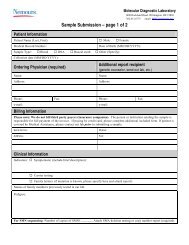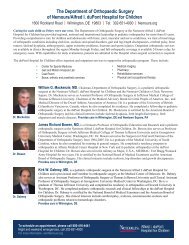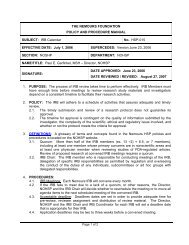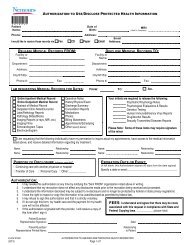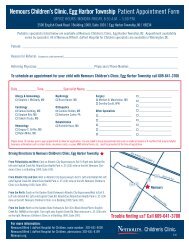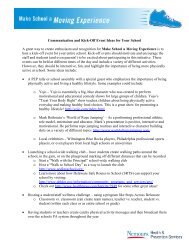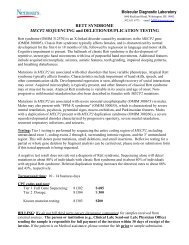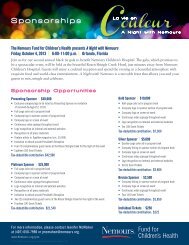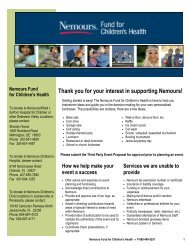Best Practices for Healthy Eating Guide - Nemours
Best Practices for Healthy Eating Guide - Nemours
Best Practices for Healthy Eating Guide - Nemours
You also want an ePaper? Increase the reach of your titles
YUMPU automatically turns print PDFs into web optimized ePapers that Google loves.
Infant Feeding<br />
Breastfeeding<br />
Breast milk is the ideal food <strong>for</strong> infants. In fact, the<br />
American Academy of Pediatrics (AAP) recommends<br />
exclusive breastfeeding <strong>for</strong> the first six months of an infant’s<br />
life. During this time, no other foods or beverages should<br />
be served. At six months, solid foods can be gradually<br />
introduced to an infant’s diet. However, breastfeeding<br />
should continue until at least 12 months, and as long as<br />
desired by mother and baby. Breastfeeding has been shown<br />
to reduce infants’ risk of developing many common illnesses<br />
and chronic conditions such as asthma, diabetes, ear<br />
infections, respiratory tract infections, dermatitis, and celiac<br />
disease. Infants who are breastfed are also less likely to be<br />
overweight or obese. 1 Additionally, breastfeeding promotes<br />
bonding between a mother and her infant.<br />
As an early care and education (ECE) provider, you<br />
have a very important role in promoting and facilitating<br />
breastfeeding among the families you serve. If a mother<br />
wishes to breastfeed, work with her to develop a system<br />
to ensure that an ample supply of breast milk is available<br />
while the infant is in your care. This includes having a<br />
refrigerator/freezer available <strong>for</strong> breast milk storage and/<br />
or a designated private space <strong>for</strong> mothers to pump or<br />
breastfeed. Breast milk should be clearly labeled with each<br />
infant’s name and the date on which it was expressed. This<br />
ensures that an infant receives only his/her own mother’s<br />
breast milk and that the breast milk is safe <strong>for</strong> consumption.<br />
It is very important to familiarize yourself with the safe<br />
storage and preparation of breast milk. Below are some<br />
helpful tips and guidelines:<br />
n Never microwave breast milk! It is best to defrost<br />
breast milk either in the refrigerator overnight,<br />
by running under warm water, or by setting it in<br />
a container of warm water. Thawed breast milk<br />
should be used within 24 hours. Do not refreeze<br />
unused milk.<br />
n If an infant doesn’t finish the bottle of breast milk<br />
within one hour, throw out the rest. Bacteria from<br />
saliva can contaminate the milk and make the<br />
infant sick if he/she drinks it later.<br />
n At room temperature, a bottle of breast milk can<br />
safely stay out <strong>for</strong> 3 – 4 hours.<br />
n Breast milk can be safely stored in the refrigerator<br />
<strong>for</strong> 48 – 72 hours.<br />
n Breast milk can be safely stored in the freezer <strong>for</strong><br />
up to six months.<br />
n Always store breast milk in the back of the<br />
refrigerator or freezer, as this is the coldest spot.<br />
Infant Formula<br />
If breastfeeding is not possible or desired, iron-<strong>for</strong>tified<br />
infant <strong>for</strong>mula is an acceptable alternative. As with<br />
breast milk, <strong>for</strong>mula should be clearly labeled with the<br />
infant’s name. Never switch an infant’s <strong>for</strong>mula without<br />
consultation with his/her parents/caregivers, as this could<br />
cause an adverse reaction. It is very important to familiarize<br />
yourself with the safe storage and preparation of infant<br />
<strong>for</strong>mula. Below are some helpful tips and guidelines:<br />
n Always follow the directions on the label carefully.<br />
n If an infant doesn’t finish the bottle of <strong>for</strong>mula<br />
within one hour, throw out the remainder.<br />
Bacteria from saliva can contaminate the <strong>for</strong>mula<br />
and make the infant sick if he/she drinks it later.<br />
n To prevent waste and save time, mix a large batch<br />
of <strong>for</strong>mula and divide it into bottles that you can<br />
refrigerate and use throughout the day.<br />
n At room temperature, prepared infant <strong>for</strong>mula<br />
can safely stay out <strong>for</strong> up to two hours.<br />
n If warmed, prepared infant <strong>for</strong>mula can safely<br />
stay out at room temperature <strong>for</strong> up to one hour.<br />
n Prepared infant <strong>for</strong>mula can be safely stored in the<br />
refrigerator <strong>for</strong> up to 24 hours.<br />
Solid/Complementary Foods<br />
At around six months, infants may be slowly introduced<br />
to solid foods if they show signs that they are<br />
developmentally ready. These include:<br />
n The absence of tongue thrust reflex (baby’s<br />
tongue doesn’t automatically push food back<br />
out of his mouth)<br />
n Good head and neck control<br />
n Opening their mouths when food comes<br />
toward them<br />
n Doubling of birth weight<br />
n An increased demand <strong>for</strong> breast milk or <strong>for</strong>mula<br />
that continues <strong>for</strong> several days<br />
When solid foods are introduced, the AAP recommends that<br />
single-ingredient foods be given one at a time. You should<br />
wait at least two to three days between offering new foods,<br />
so that it will be easier to identify the food if the infant<br />
experiences an adverse reaction (i.e., allergy or intolerance).<br />
For most children it doesn’t matter what the first foods<br />
are—whole grain cereals, or pureed vegetables, fruits and<br />
meats. Breastfed babies may benefit from baby foods made<br />
with meat, as these increase iron and zinc absorption.<br />
ECE providers should not introduce new solid foods<br />
without first consulting an infant’s parents/caregivers.<br />
1 American Academy of Pediatrics (2012). Policy Statement: Breastfeeding and the Use of Human Milk. Pediatrics, 129(3):e827-e841. Accessed on January 7, 2013 at http://<br />
pediatrics.aappublications.org/content/early/2012/02/22/peds.2011-3552.full.pdf+html<br />
<strong>Best</strong> <strong>Practices</strong> <strong>for</strong> <strong>Healthy</strong> <strong>Eating</strong> 7



